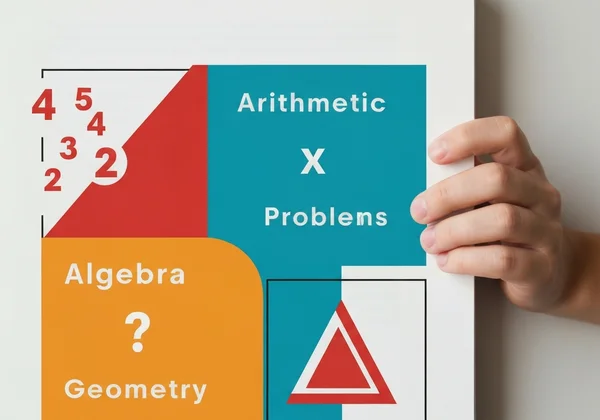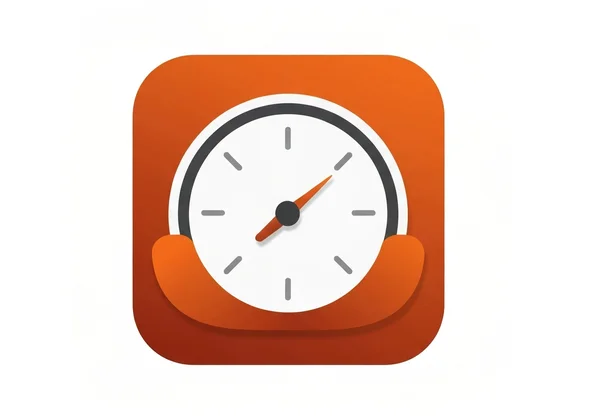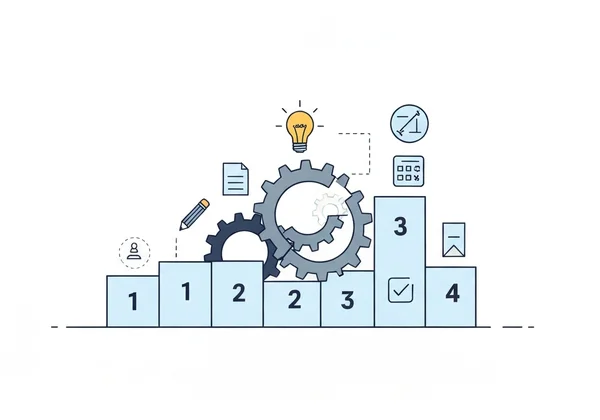Wonderlic Math Questions: Step-by-Step Guide & Practice
The math section of the Wonderlic test can seem daunting. With the clock ticking and no calculator in sight, even simple arithmetic can feel like a major hurdle. If you're feeling anxious about facing the quantitative challenges, you've come to the right place. This guide will cut through the confusion around Wonderlic math questions. We'll break down the key concepts and give you practical strategies to solve them quickly and confidently.
So, what kind of math is on the Wonderlic test? This guide will walk you through everything from basic arithmetic to tricky word problems. By the end, you'll not only understand the questions but also have a clear path to mastering them. The best way to build confidence is through practice, and our platform provides the perfect environment to apply what you learn. Are you ready to turn your math anxiety into a competitive advantage? Get started with a free practice test to see where you stand.
What Kind of Math is on the Wonderlic Test?
The Wonderlic test isn't designed to stump you with advanced calculus. Instead, it focuses on your ability to perform practical, real-world calculations quickly and accurately. The math problems primarily test your foundational knowledge in a few key areas. Understanding these categories is the first step toward efficient and effective preparation.

Essential Arithmetic & Number Series Questions
This is the bedrock of the Wonderlic math section. You'll encounter questions that test your fluency with basic operations: addition, subtraction, multiplication, and division. These problems often involve fractions, decimals, and percentages. A significant portion of this category also includes number series questions, where you must identify the pattern in a sequence of numbers and determine the next logical number. These test your logical reasoning and pattern recognition skills as much as your calculation ability.
Basic Algebra and Equation Solving
Don't let the word "algebra" intimidate you. The Wonderlic typically includes straightforward algebraic problems that require you to solve for an unknown variable (like 'x'). These are usually simple, single-variable linear equations. The key is to quickly isolate the variable using fundamental algebraic rules. Mastering this skill can save you precious seconds during the test and is a critical part of your Wonderlic test prep.
Tackling Word Problems & Ratio Challenges
Word problems are a major component of the math section because they test your ability to translate written language into a mathematical equation and then solve it. These questions often involve calculating rates (e.g., speed, distance, time), determining percentages, or working with ratios and proportions. The primary challenge is quickly identifying the relevant information, setting up the correct formula, and performing the calculation under pressure.
Geometry Fundamentals You Need to Know
While less common than arithmetic or word problems, basic geometry questions can appear. These problems will not require complex theorems or proofs. Instead, they focus on fundamental concepts like calculating the area and perimeter of simple shapes (squares, rectangles, circles) or determining volumes of basic solids like cubes. Knowing these core formulas by heart is essential to avoid getting stuck.
Mastering Wonderlic Math: Strategies and Shortcuts
Knowing what is on the test is only half the battle. The other half is knowing how to tackle the questions efficiently. With only 12 minutes to answer 50 questions, every second counts. The following strategies are designed to help you optimize your performance on the math problems.

Time Management: Speed & Accuracy Techniques
You have an average of about 14 seconds per question. This means you cannot afford to get bogged down on any single problem. A crucial strategy is to quickly scan the math problems, answer the ones you know immediately, and mark the more time-consuming ones to return to later if time permits. Don't sacrifice accuracy for speed, but practice finding the balance. The best way to hone this skill is by taking a timed practice exam.
Estimation & Mental Math Hacks
Since you can't use a calculator, strong mental math and estimation skills are your best friends. For questions involving large numbers or complex decimals, rounding and estimating can often get you close enough to the correct answer among the multiple-choice options. Practice doing quick calculations in your head. For example, instead of calculating 19 x 31 exactly, estimate it as 20 x 30 = 600 to quickly eliminate answers that are far off.
The No-Calculator Rule: What It Means for You
The strict no-calculator rule is a core feature of the Wonderlic test. This policy is in place to assess your raw cognitive ability to manipulate numbers and solve problems mentally. This means you must be comfortable with manual calculations. Before your test day, dedicate time to drilling your multiplication tables and practicing long division, fraction conversions, and percentage calculations by hand. The more you practice without a calculator, the more natural it will become.

Step-by-Step Wonderlic Math Examples with Solutions
Let's put these strategies into practice. Here are a few examples that mirror the types of questions you'll find on the Wonderlic test, along with a step-by-step breakdown of how to solve them.

Arithmetic Example & Solution
Question: A bakery sold 30% of its 200 cookies. How many cookies were sold?
- Step 1: Understand the Goal. The question asks for 30% of 200.
- Step 2: Convert the Percentage. Convert 30% to a decimal by moving the decimal point two places to the left: 30% = 0.30.
- Step 3: Calculate. Multiply the total number of cookies by the decimal: 200 * 0.30.
- Step 4: Solve. 200 * 0.3 = 60.
- Answer: The bakery sold 60 cookies.
Algebra Example & Solution
Question: If 4x + 7 = 23, what is the value of x?
- Step 1: Isolate the Variable Term. To get the term with 'x' by itself, subtract 7 from both sides of the equation.
- Step 2: Perform the Subtraction. 4x + 7 - 7 = 23 - 7, which simplifies to 4x = 16.
- Step 3: Solve for x. Divide both sides of the equation by 4 to find the value of x.
- Step 4: Perform the Division. 4x / 4 = 16 / 4, which simplifies to x = 4.
- Answer: The value of x is 4.
Word Problem Example & Solution
Question: A car travels at a constant speed of 60 miles per hour. How far will it travel in 45 minutes?
- Step 1: Identify Key Information. Speed = 60 mph. Time = 45 minutes.
- Step 2: Unify the Units. The speed is in miles per hour, but the time is in minutes. Convert minutes to hours by dividing by 60. 45 minutes = 45/60 hours = 3/4 hours (or 0.75 hours).
- Step 3: Use the Formula. The formula for distance is Distance = Speed × Time.
- Step 4: Calculate. Distance = 60 mph × 0.75 hours. 60 * 3/4 = (60 * 3) / 4 = 180 / 4 = 45.
- Answer: The car will travel 45 miles.
Your Path to Acing Wonderlic Math
You absolutely can ace Wonderlic math questions! It's all about a smart approach: know the problem types, use clever strategies like estimation, manage your time, and practice, practice, practice. That's how you build confidence and boost your score.
Ready to put this into action? The best way to solidify these skills is in a realistic, timed environment. We encourage you to take the next step in your preparation by taking a full-length, free simulated test on our platform. You'll receive instant scoring and can even unlock a unique AI-powered analysis to identify your specific strengths and weaknesses, giving you a customized plan for improvement.
Frequently Asked Questions About Wonderlic Math
Can you use a calculator on the Wonderlic test?
No, calculators are strictly prohibited during the Wonderlic test. All calculations, including multiplication, division, fractions, and percentages, must be done mentally or by hand using the scratch paper provided. This is why strengthening your mental math skills through tools like a simulated test is so critical for success.
What kind of math is on the Wonderlic test?
The math on the Wonderlic test covers basic arithmetic (fractions, decimals, percentages), number series and patterns, simple algebra (solving for 'x'), and practical word problems involving rates, ratios, and averages. Occasionally, very basic geometry questions about area or perimeter may appear. It focuses on foundational quantitative reasoning rather than advanced mathematical theory.
Is the Wonderlic test hard, especially the math section?
The difficulty of the Wonderlic test comes from its intense time pressure, not necessarily the complexity of the questions themselves. The math problems are generally at a middle school or early high school level. However, performing these calculations quickly and accurately in under 15 seconds per question is what makes it challenging. Consistent practice helps make the math section much more manageable.
How long is the Wonderlic test, and how much time for math?
The most common version of the Wonderlic Cognitive Ability Test consists of 50 questions to be answered in 12 minutes. There isn't a separate, timed section for math; the math questions are mixed in with verbal, logic, and spatial reasoning problems. You must manage your 12 minutes across all question types, making it essential to answer the math questions you know quickly to save time for others.